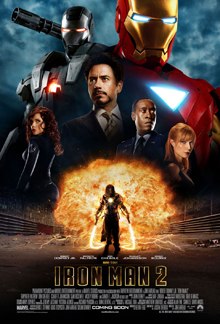“Iron Man 2” is a superhero
movie based on the popular Marvel comic book character. It set a new standard
for how films of the superhero genre integrate special effects and computer
animation with live action. A critical success (it received a rating of 74% on
Rotten Tomatoes, unusually high for a sequel) and a fan favorite (it was met
with favorable reviews by comic junkies), Iron Man 2 was the catalyst for more
Marvel film adaptations and, thus, The Avengers.
The use of crystal-clear special
effects is apparent in the very first main scene of the movie. Tony Stark is
driving a Formula 1 car in a race in Monaco when the antagonist of the film,
Ivan Vanko, steps out onto the track with a homemade, whip-like lighting
weapon. As Stark is about to crash into him, Vanko lashes out with the whip,
slicing the car in half and sending Iron Man’s alter ego hurdling through the
air. The camera zooms into Stark’s face, showing the fear in the face of a man
who is usually annoyingly complacent while the car is cut perfectly in half,
with sparks showering down from the white-hot metal. This not only creates a
dazzling image but also shows how Ivan Vanko effectively uses pathos to scare
both Tony Stark as well as the audience into submission.
One of the more impressive
features of the film is the equipment that Stark uses throughout the story. With
the sophisticated special effects that director Jon Favreau had at his
disposal, the technology seemed not only plausible but logical. The way that
the Iron Man suit robotically attaches itself to Stark is so intricately
designed that it makes me feel as if I could go find it at The Sharper Image. Said
Favreau of the special effects in an interview with ‘Chuck the Movieguy,’ “Five
years ago you couldn’t make an Iron Man movie that showed the suit doing
everything it could do in the books.” Furthermore, Stark’s butler/Artificial
Intelligence computer will surely have tech geeks raving. The screen is a
hologram capable of filling his entire workshop, a “galaxy-like” display of
icons and applications that can be opened, rearranged, and even tossed in the
garbage with a flick of the wrist. This use of logos argues not only that Tony
Stark is a genius, innovative, technological mastermind but also that this kind
of technology simply can’t be that far away.
The
movie also employed ethos in a very realistic medium as well. In the scene
where Stark is taken before the Senate to hand his suit over to the government,
the camera switches from the standard view to a news broadcast. The camera view
is complete with not only the ever-popular “Live” bar at the top of the screen,
but also the actual C-Span logo and the trademark title and subtitle. This
makes the hearing more serious and convincing to the audience, while at the
same time makes it even funnier that Stark is mocking the entire thing. Other
scenes show Stark from the point of view of the heads-up display in his helmet.
This gives the viewer a sense of excitement, making them feel as if they’re
right there inside the suit with Iron Man, shooting lasers and missiles at the
bad guys.
In a genre of its own where
special effects are often criticized, Iron Man 2 succeeds where others have
failed. It is a breath of remarkably fresh air for superhero films (just watch
the corny stunts in the 1997 Batman & Robin). Iron Man 2 is also proof that
the movie industry hasn’t fallen into the hands of “moneygrubbing hacks” with
no artistic taste that Giannetti is worried about, due to our technology today.
Rating: 4/5

No comments:
Post a Comment